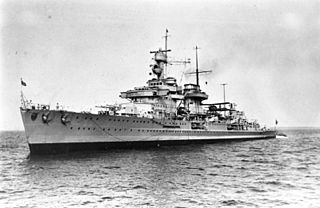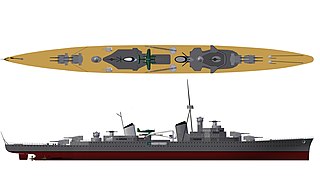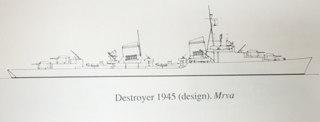
The German aircraft carrier Graf Zeppelin was the lead ship in a class of two carriers of the same name ordered by the Kriegsmarine of Nazi Germany. She was the only aircraft carrier launched by Germany and represented part of the Kriegsmarine's attempt to create a well-balanced oceangoing fleet, capable of projecting German naval power far beyond the narrow confines of the Baltic and North Seas. The carrier would have had a complement of 42 fighters and dive bombers.

The Scharnhorst class was a class of German battleships built immediately prior to World War II. The first capital ships of Nazi Germany's Kriegsmarine, it comprised two vessels: Scharnhorst and Gneisenau. Scharnhorst was launched first, and is considered to be the lead ship by some sources; they are also referred to as the Gneisenau class in some other sources, as Gneisenau was the first to be laid down and commissioned. They marked the beginning of German naval rearmament after the Treaty of Versailles. The ships were armed with nine 28 cm (11 in) SK C/34 guns in three triple turrets; plans to replace these with six 38 cm (15 in) SK C/34 guns in twin turrets were never realized.

The Königsberg class, sometimes referred to as the K class, was a class of light cruisers of the German Reichsmarine and Kriegsmarine. The class comprised three ships named after German cities: Königsberg, Karlsruhe, and Köln, all built between 1926 and 1930. These ships were the first of the Reichsmarine with a modern cruiser design; their predecessor, Emden, was based on World War I-era designs. They were armed with a main battery of nine 15 cm (5.9 in) guns and with twelve 50 cm (20 in) torpedo tubes.

Nürnberg was a German light cruiser of the Leipzig class built for the Kriegsmarine. She was named after the city of Nuremberg and had one sister ship, Leipzig. Nürnberg was laid down in 1934, launched in December of that year, and completed in November 1935. She was armed with a main battery of nine 15 cm (5.9 in) guns in three triple turrets and could steam at a speed of 32 knots. Nürnberg was the longest-serving major warship of the Kriegsmarine, and the only one to see active service after the end of World War II, though not in a German navy.

The Admiral Hipper class was a group of five heavy cruisers built by Nazi Germany's Kriegsmarine beginning in the mid-1930s. The class comprised Admiral Hipper, the lead ship, Blücher, Prinz Eugen, Seydlitz, and Lützow. Only the first three ships of the class saw action with the German Navy during World War II. Work on Seydlitz stopped when she was approximately 95 percent complete; it was decided to convert her into an aircraft carrier, but this was not completed either. Lützow was sold incomplete to the Soviet Union in 1940.

Seydlitz was a heavy cruiser of Nazi Germany's Kriegsmarine, fourth in the Admiral Hipper class, but was never completed. The ship was laid down in December 1936 and launched in January 1939, but the outbreak of World War II slowed her construction and fitting-out work was finally stopped in the summer of 1940 when she was approximately 95 percent complete. The unfinished ship remained pier-side in the shipyard until March 1942, when the Kriegsmarine decided to pursue aircraft carriers over surface combatants. Seydlitz was among the vessels chosen for conversion into auxiliary aircraft carriers.

The Leipzig class was a class of two light cruisers of the German Reichsmarine and later Kriegsmarine; the class comprised Leipzig, the lead ship, and Nürnberg, which was built to a slightly modified design. The ships were improvements over the preceding Königsberg-class cruisers, being slightly larger, with a more efficient arrangement of the main battery and improved armor protection. Leipzig was built between 1928 and 1931, and Nürnberg followed between 1934 and 1935.

The O class was a planned class of three battlecruisers for the Kriegsmarine before World War II. Prompted by a perceived lack in ship numbers when compared with the British Royal Navy, the O class' design was born with the suggestion of modifying the P-class cruiser design with 380 mm (15 in) guns instead of 283 mm (11.1 in).

The M-class cruisers were a class of light cruisers planned, but never built, by Nazi Germany's Kriegsmarine before World War II. The ships were designed for commerce raiding in the Atlantic Ocean. The design for the first four ships suffered from a number of problems, and so the fifth and sixth ships were substantially redesigned.

The Graf Zeppelin-class aircraft carriers were four German Kriegsmarine aircraft carriers planned in the mid-1930s by Grand Admiral Erich Raeder as part of the Plan Z rearmament program after Germany and Great Britain signed the Anglo-German Naval Agreement. They were planned after a thorough study of Japanese carrier designs. German naval architects ran into difficulties due to lack of experience in building such vessels, the situational realities of carrier operations in the North Sea and the lack of overall clarity in the ships' mission objectives.
The German aircraft carrier I was a planned conversion of the transport ship Europa during World War II. The loss of the battleship Bismarck and near torpedoing of her sistership Tirpitz in May 1941 and March 1942, respectively, spurred the Kriegsmarine to acquire aircraft carriers. Europa was one of several vessels selected for conversion into auxiliary aircraft carriers. As designed, the ship would have had an air complement of 24 Bf 109T fighters and 18 Ju 87C Stuka dive-bombers.

The H class was a series of battleship designs for Nazi Germany's Kriegsmarine, which were intended to fulfill the requirements of Plan Z in the late 1930s and early 1940s. The first variation, "H-39", called for six ships to be built, essentially as enlarged Bismarck-class battleships with 40.6 cm (16 in) guns and diesel propulsion. The "H-41" design improved the "H-39" ship with still larger main guns, eight 42 cm (16.5 in) weapons, and reinforced deck armor. The Construction Office of the Oberkommando der Marine (OKM) concluded their work with the "H-41" design, and were not involved in subsequent plans. Two of them, "H-42" and "H-43", increased the main battery yet again, with 48 cm (18.9 in) pieces, and the enormous "H-44" design ultimately resulted with 50.8 cm (20 in) guns. The ships ranged in size from the "H-39", which was 277.8 m long on a displacement of 56,444 t, to the "H-44", at 345 m on a displacement of 131,000 t. Most of the designs had a proposed top speed in excess of 30 knots (56 km/h).

Tirpitz was the second of two Bismarck-class battleships built for Nazi Germany's Kriegsmarine (navy) prior to and during the Second World War. Named after Grand Admiral Alfred von Tirpitz, the architect of the Kaiserliche Marine, the ship was laid down at the Kriegsmarinewerft in Wilhelmshaven in November 1936 and her hull was launched two and a half years later. Work was completed in February 1941, when she was commissioned into the German fleet. Like her sister ship, Bismarck, Tirpitz was armed with a main battery of eight 38-centimetre (15 in) guns in four twin turrets. After a series of wartime modifications she was 2000 tonnes heavier than Bismarck, making her the heaviest battleship ever built by a European navy.

Lützow was a heavy cruiser of Nazi Germany's Kriegsmarine, the fifth and final member of the Admiral Hipper class, but was never completed. The ship was laid down in August 1937 and launched in July 1939, after which the Soviet Union requested to purchase the ship. The Kriegsmarine agreed to the sale in February 1940, and the transfer was completed on 15 April. The vessel was still incomplete when sold to the Soviet Union, with only half of her main battery of eight 20.3 cm (8 in) guns installed and much of the superstructure missing.

The aircraft carrier II was a proposed conversion project for the incomplete French cruiser De Grasse. The ship was laid down in November 1938 and lay incomplete in the Arsenal de Lorient shipyard when Germany invaded France in May 1940. In 1942, Nazi Germany's Kriegsmarine decided to convert the cruiser into an auxiliary aircraft carrier with a capacity for twenty-three fighters and dive bombers. Work ceased in February 1943, however, due to concerns with the ship's design, a severe shortage of material and labor, and the threat of Allied bombing raids. The ship was eventually completed as an anti-aircraft cruiser in 1956 by the French Navy.

Empire Fowey was a 19,121 GRT ocean liner that was built in 1935 as Potsdam by Blohm & Voss, Hamburg for the Hamburg America Line. She was sold before completion to Norddeutscher Lloyd. While owned by Norddeutscher Lloyd she was one of three sister ships operating the service between Bremen and the Far East. Her sister ships were SS Scharnhorst and SS Gneisenau.

The Type 1945 destroyers were a planned class of destroyers, for the Kriegsmarine, whose design was based upon that of the Type 1936D and E destroyers. Their plan involved a return to steam boilers, which had been replaced by diesel engines in all ships designs after the Type 1942 destroyers. No ships were ever built, as the end of the war was rapidly approaching.
The Type 1941 torpedo boats were a group of 15 torpedo boats that were built for Nazi Germany's Kriegsmarine during World War II. Ordered in late 1942, none of the ships were finished before the German surrender on 8/9 May 1945, although four of the ships had been towed west to be completed earlier in that year. They were all either scuttled or demolished in the shipyard in 1945–1946.

The Type 1940 torpedo boats were a group of 24 torpedo boats that were intended to be built for Germany's Kriegsmarine during World War II. Although classed as fleet torpedo boats by the Germans, they were comparable to contemporary large destroyers. They were designed around surplus Dutch propulsion machinery available after the Germans conquered the Netherlands in May 1940 and were to be built in Dutch shipyards. Hampered by uncooperative Dutch workers and material shortages, none of the ships were completed before the Allies invaded Normandy in June 1944. The Germans towed the three ships that were most complete to Germany to be finished, but one was sunk en route by Allied fighter-bombers and no further work was done of the pair that did arrive successfully. The remaining ships in the Netherlands were later broken up for scrap and the two that reached Germany were scuttled in 1946.















